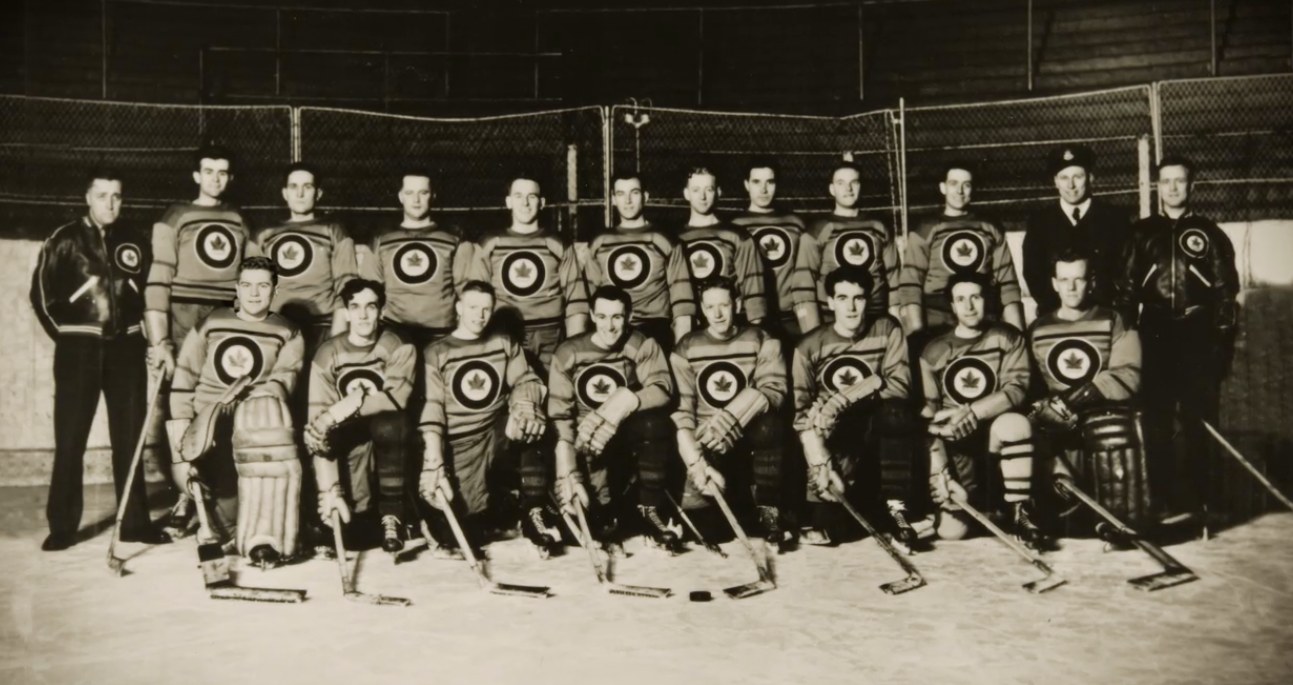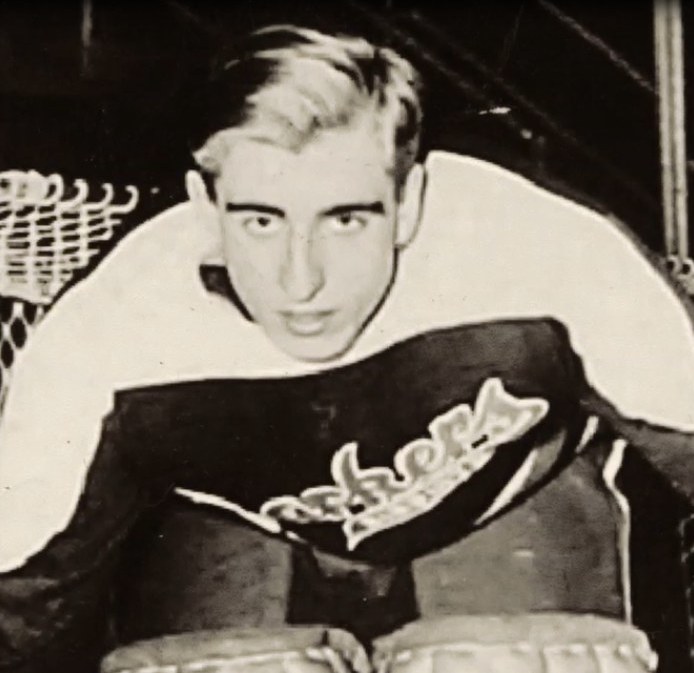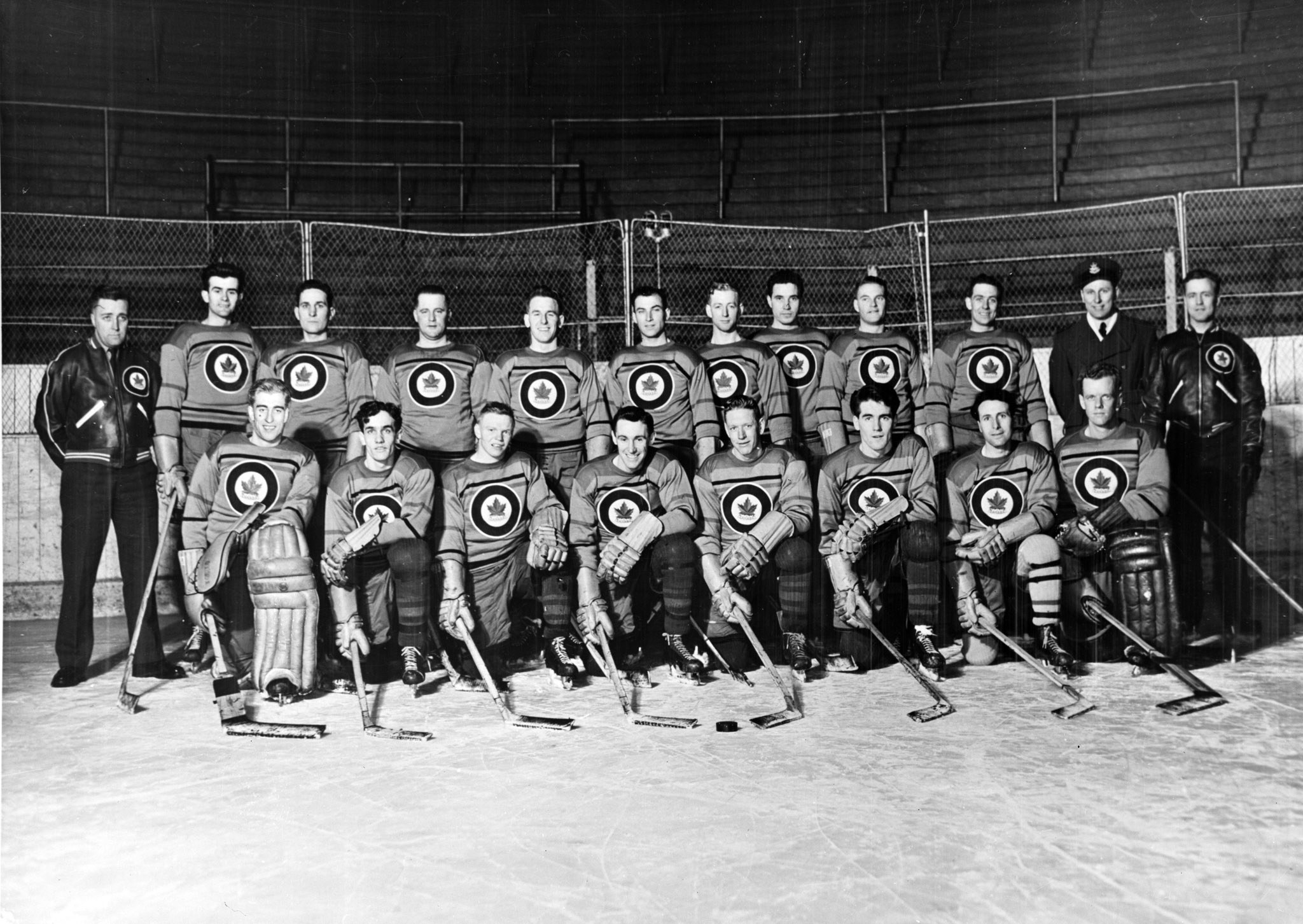
The Life and Times of Hubert Brooks M.C. C.D.
A Canadian Hero

 |
|
 |
The announcement (of what we thought) would be the final composition of the RCAF Flyer Olympic team occurred on December 31, 1947, effectively 9 days before we set sail for Europe.
![]() Jack Koffman’s article in The Ottawa Citizen (page 14 December 31,1947) proclaimed:
Jack Koffman’s article in The Ottawa Citizen (page 14 December 31,1947) proclaimed:
Dick Ball Is New Goaler On RCAF Olympic Ice Squad
Refs: 8.12 & 8.13
The axe fell for the last time yesterday in the camp of the RCAF Olympic hockey team, lopped off four more players from the roster, and
left seventeen athletes to represent the Dominion at St Moritz, Switzerland January 30th to February 8th. Cheering
news........ Is the fact that the team includes a new goaler, Dick Ball, whose net–wizardry helped University of Toronto reach
senior intercollegiate ice heights last spring.......Ball, with Toronto Varsity for the past two years, flew in from the Queen City yesterday
in time to join the team for their five o’clock workout on Auditorium ice. He stayed between the pipes as the Air Force goaler for part of
the practice game with the QSHL Senators and his work was impressive enough to win the approval of Selection Coach Buck Boucher, Coach Frank
Boucher and Manager Sandy Watson.
|
The Complete Team Goal
Defense
Forwards
EXTRAS
|
|

|
In addition to the 17 players there will be Coach Frank Boucher, Manager Sandy Watson, and Trainer George McFaul.
Only 10 members of the announced RCAF Flyers team were "regulars" in the RCAF but "most" of the newcomers were to be placed on the RCAF Reserve to make it an all Air Force team!

|
The official team PHOTO (see above) was taken circa January 3, 1948- however it was quickly superceeded a few days later with an updated version.... see below.
So of the 18 players who represented the Olympic team in their first big test against McGill on December 13th,
ten have been dropped.
(Ed Note: The eight remaining from the original selection identified with asterisks in the above list)
Those who haven’t seen the now current Canadian Olympic hockey representatives since our defeat against McGill and the Army would have difficulties recognizing the squad. There is little, if any, resemblance between the RCAF team of two weeks ago and the current Boucher–led aggregation.
As it stands now the coach's plan was that; Hibberd will center Renaud and Schroeter on one line; Leichnitz will serve
as pivot man for Forbes and Gravelle, while Mara is center for Gilpin and Taylor.
Guzzo and Brooks are utility men, and can fill in at either wing or in center.
Some player PHOTOS taken were as follows:
|
|
|
|
Extracts from Tommy Shields Column in The Ottawa Citizen (December 31, 1947 page 14) summed up most
sports writer's opinions:
The first look we had at the RCAF Olympic hockey team....... The situation appeared hopeless.......Last night we had another look at the
team......the Airmen now have a hockey team. Changes and recent additions have raised the Olympics up from a lowly rating to a point
where they now can be looked upon as a squad capable of representing Canada creditably......… There is much room for improvement, but
there does not appear to be anything wrong with the team that cannot be corrected by continued practice. We do not wish to leave the impression
that the team as it now stands could step out and win the Allan Cup. They are far removed from that classification, but they have improved so
much that their officials and supporters, CAHA officials and Canadian hockey fans in general, can expect this aggregation to make a good
showing unless they run into opposition that outclasses them. In the practice match against the Senators (currently first place in the QSHL)
last night they were outclassed .....but the Olympics showed flashes of good hockey. ......Nevertheless the outlook today is brighter for
RCAF officials ...... and they now can devote their entire attention to whipping the team into shape and into a smooth–functioning
unit….... practice and games during the course of their European pre–Olympic tour will see them round into worthwhile opposition….....
The recent additions to the squad apparently are short on condition, but have shown in their brief appearances .....that they have the ability
to add strength and punch to the team in the very near future. .....It will be most interesting to look at the RCAF team over time and then
think back to the first time they appeared here on skates as a team.
To add a little fuel to the fire, at this time Reuters news agency reported from Europe that the days of North American hockey domination were coming to an end. In the past, Canadians had gone overseas to teach Europeans the game. "The lessons ", the news agency said "had been learned. The US and Canada should send their best amateur teams if they wanted to win in St. Moritz."
The general press consensus of the Canadian team was that here was no way this "ragtag bunch" could
win on the world stage in 1948.
Even with the reinforcements, the team was given poor odds to recapture gold.
Czechoslovakia was the favourite, followed by Sweden and Switzerland. Canada would do well to finish fourth.
On January 3rd after a rough practice with the Air Force City League team Ab Renaud suffered torn knee ligaments and Andy Gilpin received a leg injury. Both were forcasted to be out of hockey for at least a week.
It was at this time that we had our official RCAF Flyer Olympic hockey team photo taken.
But fate was not so kind to designated goalie Dick Ball. No sooner had the official team photo been taken that on January 5, 1948
the final medical check suggested that Ball had a lung infection which would prevent him from travelling! He was grounded and off the team. Ball feared he might have tuberculosis.
(Editor's Note: Further tests revealed he was in perfect health, but by then the team had set sail for Europe and glory. Ball could only wonder what might have been. Ball then led his Maher Shoes team in the industrial Toronto Hockey League to the league championship in 1948-49)

|

|

|

|
His appearance did not immediately impress Watson.
"Around noon 8–January a skinny, bedraggled kid, looking like something dragged through a knot hole, arrived at my office in
Ottawa."
"We swore him in the Royal Canadian Air Force, got him kitted up with a uniform and he looked even worse!"
Dowey had arrived just in time to join the team for the train trip to New York to catch the Queen Elizabeth the next day.
No decision had been made as to whether Dowey would be the team's No. 1 goaler or whether Ross King would move into the main spot. Once the Flyersarrived overseas, Dowey would have an opportunity to show his stuff in the pre-Olympic exhibition games, and thereafter a goaler decision would be made.
The team didn’t see him play until our first exhibition game in London. He didn’t look like a hockey
player,
but he had fast hands – quick as lightning. As it would turn out, the team was lucky by being unlucky – Downy turned
out to be a great addition.
(As indicated above, Dowey, who would become the team’s number one goalie, arrived so late in fact that he wasn’t around when
the official team photo was taken. However, the pros at the RCAF photographic lab made sure he was in the team photo. They cleverly
pasted a picture of Dowey’s head onto the body of Dick Ball. It takes a very close look to discover the ruse.)

|

|
Individual photos were also then taken of each of the players.
|
|
|
|
The RCAF Flyer Player PHOTOS in this Section were provided by the Estate of Pat Guzzo via his daughter Mary Rose.
|
| PREVIOUS PAGE | GO TO TOP OF PAGE FOR INTER- and INTRA- CHAPTER NAVIGATION MENUS |
NEXT PAGE |
The Life and Times of Hubert Brooks M.C. C.D.